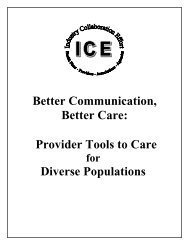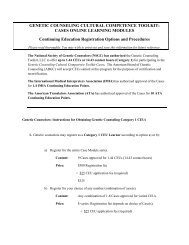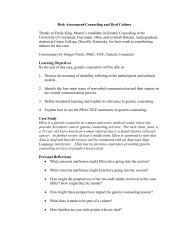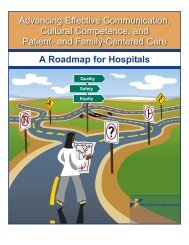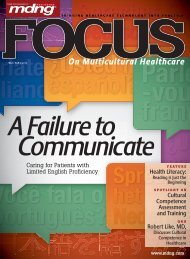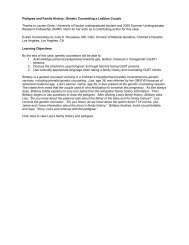making the business case for culturally and linguistically appropriate ...
making the business case for culturally and linguistically appropriate ...
making the business case for culturally and linguistically appropriate ...
You also want an ePaper? Increase the reach of your titles
YUMPU automatically turns print PDFs into web optimized ePapers that Google loves.
APPENDIX O- Project MethodologyThe Alliance of Community Health Plans (ACHP) Foundation with funding from <strong>the</strong> WhitehouseStation, NJ-based Merck Company Foundation (<strong>the</strong> philanthropic arm of pharmaceutical companyMerck & Co., Inc.), undertook an assessment to provide in<strong>for</strong>mation about CLAS projects thatproduced a <strong>business</strong> benefit so that organizations pursuing CLAS in health care would havein<strong>for</strong>mation <strong>for</strong> planning <strong>and</strong> decision-<strong>making</strong> about implementation of CLAS in <strong>the</strong>ir organizations.In 2005, ACHP empanelled an advisory committee of health plan <strong>and</strong> o<strong>the</strong>r experts in CLASactivities to help guide <strong>the</strong> process of collecting from health plans <strong>and</strong> o<strong>the</strong>r health careorganizations in<strong>for</strong>mation that identifies benefits that have been realized from implementation ofCLAS St<strong>and</strong>ards-related projects. The meeting focused on both descriptive <strong>and</strong> quantitativein<strong>for</strong>mation available. ACHP used <strong>the</strong> partners to help identify: 1) important topics to address, <strong>and</strong>2) <strong>the</strong> kinds of in<strong>for</strong>mation available in <strong>the</strong>ir plans or organizations (or elsewhere) that could beincluded in this project. This group included ACHP member plans, non-member health plans <strong>and</strong>providers, <strong>and</strong> o<strong>the</strong>rs with a history of substantial involvement <strong>and</strong> success in CLASimplementation.Early tasks <strong>for</strong> this project included a review of existing literature. Selected materials wereannotated <strong>and</strong> shared among ACHP staff <strong>and</strong> used to in<strong>for</strong>m interview questions <strong>and</strong> design a<strong>business</strong> <strong>case</strong> study <strong>for</strong>mat. In addition, staff reviewed notes <strong>and</strong> discussions from <strong>the</strong> ACHP CLASadvisory committee from 2005. A broad list of organizational contacts were developed using peerrevieweddocuments, internet search using “CLAS” <strong>and</strong> health as key words, news articles aboutclinics implementing language interpretation services <strong>for</strong> LEP, attendance to national conferences<strong>and</strong> contacts from CLAS experts in <strong>the</strong> field.Through <strong>the</strong>se activities, ACHP identified 42 projects that have been documented in <strong>the</strong> literature<strong>for</strong> engaging <strong>and</strong> implementing CLAS st<strong>and</strong>ards (with 90% primarily documented <strong>for</strong>interventions in language access services, CLAS St<strong>and</strong>ards 4 through 7). All Forty-two projectswere contacted. Many of <strong>the</strong> projects did not have in<strong>for</strong>mation on <strong>the</strong> costs <strong>and</strong> benefits of <strong>the</strong>irinitiatives <strong>and</strong> as a result were not considered fur<strong>the</strong>r <strong>for</strong> <strong>the</strong> ACHP project. Of <strong>the</strong> list of 18projects, 13 projects were selected <strong>for</strong> <strong>business</strong> <strong>case</strong> analysis <strong>and</strong> highlighted in this report.ACHP developed a one page questionnaire <strong>and</strong> provided it to each participating organization toaccess <strong>the</strong> depth of in<strong>for</strong>mation available. Organizations highlighted include managed careorganizations, hospital systems <strong>and</strong> a rural community pediatric clinic. Comprehensive telephone<strong>and</strong> in-person interviews were conducted as well.ACHP project staff worked with health care organizations to obtain <strong>and</strong> develop relevantin<strong>for</strong>mation from <strong>the</strong>ir experience in implementing CLAS. Such in<strong>for</strong>mation ranged fromin<strong>for</strong>mation about system changes that promoted improved quality in service delivery, toquantifiable results from CLAS implementation that affect reduction of disparities or achievefinancial <strong>business</strong> objectives.Following <strong>the</strong> design <strong>and</strong> completion of <strong>the</strong> 13 <strong>business</strong> <strong>case</strong>s, each <strong>case</strong> was presented to a smallcommittee of health professionals <strong>for</strong> external review. This final report was also reviewed by <strong>the</strong>same external committee.62



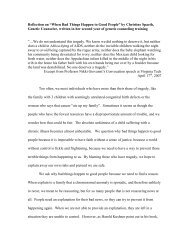
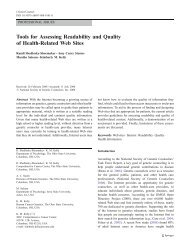

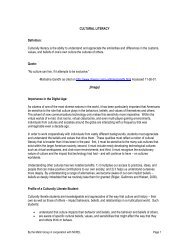
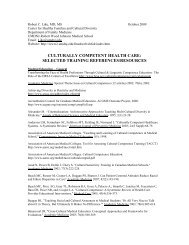

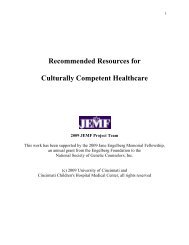
![Breaking Bad News PPT[1] - Genetic Counseling Cultural ...](https://img.yumpu.com/35003134/1/190x146/breaking-bad-news-ppt1-genetic-counseling-cultural-.jpg?quality=85)
